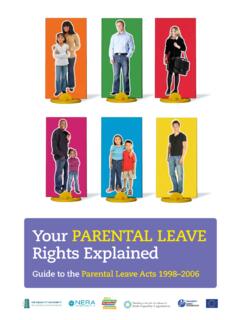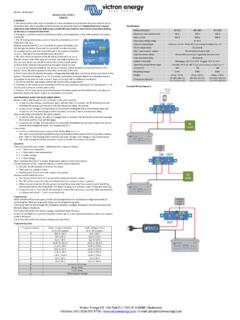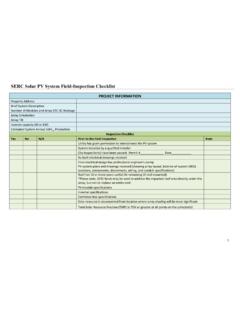Transcription of Workplace Relations Commission
1 Workplace Relations Commission CODE OF PRACTICE FOR. EMPLOYERS AND EMPLOYEES. ON THE RIGHT TO disconnect . Contents Foreword 1. Legislative Basis 2. Purpose of the Code of Practice 3. What is the Right to disconnect ? 4. Relevant Legislation 5. The Organisation of Working Time Act, 1997 5. The Safety, Health and Welfare at Work Act, 2005 5. Employment (Miscellaneous Provisions) Act, 2018 5. Terms of Employment (Information) Acts, 1994 to 2014 5. Employer and Employee Obligations 6. Best Practice Guidance on a Right to disconnect Policy 7. Raising Concerns 9. Sample Right to disconnect Policy: Layout and Template Clauses 11. Useful Resources 13. Workplace Relations Commission Code of Practice for Employers and Employees on the Right to disconnect Foreword On foot of a request from the T naiste and Minister for Enterprise, Trade and Employment, the Workplace Relations Commission (WRC).
2 Has prepared a Code of Practice to give guidance on best practice to organisations and their employees on the Right to disconnect . The world of work has changed profoundly over recent years. Technological advances mean that we are always contactable and accessible. Where, when and how we work continues to change at an accelerating pace. Employers and employees are experiencing both challenges and benefits arising from new ways of working including remote and flexible working arrangements, which encapsulates how long, where, and at what times employees work as well as the location of where work gets done. To ensure that both employers and employees can take advantage of and maximise the benefit from this changed working environment, workplaces must put in place policies and procedures to ensure that employees' rights are preserved, that employers and employees adhere to their statutory obligations, that work is carried out safely and that the working relationship between employer and employee is balanced and mutually beneficial.
3 While different working arrangements may suit different employees within their respective business environments, the right to be able to maintain clear boundaries between work and leisure is universal. This Code applies to all types of employment, whether you are working remotely, in a fixed location, at home or are mobile. I would like to acknowledge the input of all who made submissions as part of the consultation process and the work of the representatives of the Irish Business and Employers Confederation (IBEC) and the Irish Congress of Trade Unions (ICTU) who assisted the Commission in bringing this Code to finality. Liam Kelly Director General Workplace Relations Commission 1 Foreword Workplace Relations Commission Code of Practice for Employers and Employees on the Right to disconnect Legislative Basis Section 20(2) of the Workplace Relations Act, 2015 provides, at the request of the Minister, for the preparation of draft codes of practice by the WRC for submission to the Minister for Enterprise, Trade and Employment.
4 Codes of Practice are written guidelines, agreed in a consultative process, setting out guidance and best practice for employers and employees with respect to compliance with employment legislation. This statutory function fits within the WRC's overall In accordance with the provisions of section 20(4) of remit of promoting improvement and maintenance of the Workplace Relations Act, 2015, the WRC carried good Workplace Relations ; promoting and encouraging out a public consultation and received 37 submissions compliance with relevant employment, equality and equal which were fully considered in the development of this status legislation and Codes of Practice; conducting Code. In finalising the Code, the WRC engaged with reviews of, and monitoring developments in, Workplace representatives of employers and employees, including Relations generally.
5 IBEC and ICTU. While failure to follow a Code prepared under section 20(1)(a) of the Workplace Relations Act, 2015 is not an offence in itself, section 20(9) provides that in any proceedings before a Court, the Labour Court or the WRC, a Code of Practice shall be admissible in evidence and any provision of the Code which appears to the Court, body or officer concerned to be relevant to any question arising in the proceedings shall be taken into account in determining that question. Legislative Basis 2. Workplace Relations Commission Code of Practice for Employers and Employees on the Right to disconnect Purpose of the Code of Practice The purpose of this Code is to provide practical guidance and best practice to employers, employees and their representatives in relation to the Right to disconnect . Specifically, the Code is designed to: Complement and support employers' and employees' Provide assistance to those employees who feel rights and obligations under the Organisation of obligated to routinely work longer hours than those Working Time Act, 1997 (OWTA 1997), the Safety, agreed in their terms and conditions of employment.
6 Health and Welfare at Work Act, 2005 (SHWWA Assist employers in developing and implementing 2005), the Employment (Miscellaneous Provisions) Act procedures and policies to facilitate the Right to 2018 and the Terms of Employment (Information) Act disconnect . 1994 2014. Provide guidance for the resolution of Workplace issues Assist employers and employees in navigating an arising from the Right to disconnect both informally increasingly digital and changed working landscape and formally, as appropriate. which often involves remote and flexible working. 3 Purpose of the Code of Practice Workplace Relations Commission Code of Practice for Employers and Employees on the Right to disconnect What is the Right to disconnect ? The Right to disconnect refers to an employee's right to be able to disengage from work and refrain from engaging in work-related electronic communications, such as emails, telephone calls or other messages, outside normal working hours.
7 In brief, the Right to disconnect has three main elements: i. The right of an employee to not routinely perform iii. The duty to respect another person's right to work outside normal working hours. disconnect ( , by not routinely emailing or calling ii. The right to not be penalised for refusing to attend to outside normal working hours). work matters outside of normal working hours. What is the Right to disconnect ? 4. Workplace Relations Commission Code of Practice for Employers and Employees on the Right to disconnect Relevant Legislation This Code of Practice provides practical guidance for employers and employees to assist in meeting existing obligations under the following legislation, the purpose of which is, inter alia, to protect employees from working excessive hours. The Organisation of Working Time Employees have an obligation under section 13(1)(a) and 13(1)(e) of the SHWWA 2005 to take reasonable care to Act, 1997 (View full document here) protect their safety, health and welfare at work and not The OWTA 1997 has its genesis in protecting the safety, engage in improper conduct or behaviour that is likely to health and welfare of those at work.
8 The Act does not endanger his or her own safety, health and welfare at work explicitly refer to a Right to disconnect ', but states that or that of any other person'. employers cannot permit employees to work more than This includes an obligation to not work hours in excess a maximum of 48 hours per week on average, except in of the legislation and, like the OTWA 1997, contains an very limited circumstances. obligation to cooperate with any appropriate mechanism As such, employers have a legal responsibility to keep introduced by an employer for the recording of working records of employees' hours worked under the OWTA time. 1997. Employers must ensure that their employees receive specified breaks within the day, as well as their daily and Employment (Miscellaneous weekly rest. Employees must also receive their statutory Provisions) Act, 2018 (View full document here).
9 Entitlement to annual leave and public holidays. This legislation provides that employees must receive The duty to ensure compliance with the OWTA 1997 rests a written statement of their core terms of employment with the employer and not the employee. Employees within 5 days of starting employment. One of the core have a responsibility to cooperate with any appropriate terms must establish what hours of work the employer mechanism introduced by the employer for recording of reasonably expects the employee to work in a normal working time. working day and a normal working week. The Safety, Health and Welfare at In this regard, normal working hours are those as agreed in an employee's terms and conditions of employment, as Work Act, 2005 (View full document here) governed by the employee's contract of employment and/. The SHWWA 2005 makes further provision for the safety, or applicable collective agreement and/or any applicable health and welfare of persons at work.
10 The Act sets out Sectoral Employment or Employment Regulation Order in the responsibilities of employers, the self-employed, force. employees and various other parties in relation to safety and health at work. The Act also details the role and Terms of Employment (Information). functions of the Health and Safety Authority, provides for Acts, 1994 2014. (View full document here). a range of enforcement measures that may be applied This legislation provides that employees must receive a and specifies penalties that may be applied for breach of written statement of the remaining terms of employment occupational safety and health. (a contract) within 2 months of starting employment. This Under section 8(2)(b) of the SHWWA 2005 the statement must include any terms or conditions relating employer's duties extend to managing and conducting to hours of work (including overtime) and details of any work activities in such a way as to prevent, so far as collective agreements that may affect the employee's is reasonably practicable, any improper conduct or terms of employment.













